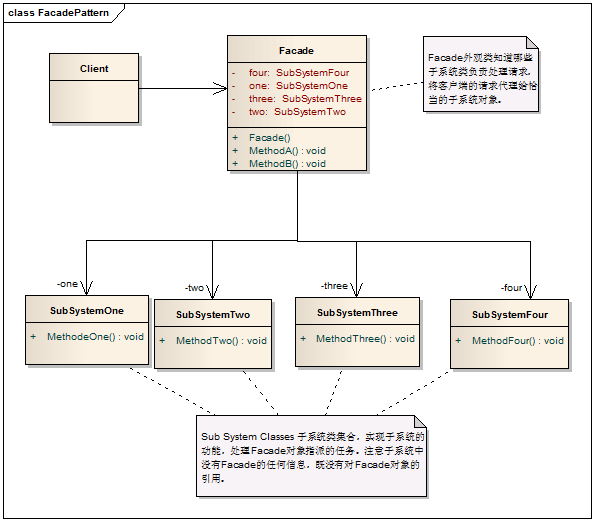C#外观模式 C# 设计模式系列教程-外观模式
Wang Juqiang 人气:01. 概述
为子系统中的一组接口提供一个一致的界面,此模式定义了一个高层接口,这个接口使得这一子系统更加容易使用。
2. 模式中的角色
2.1 外观类(Facade):外观类知道哪些子系统类负责处理请求,将客户的请求代理给恰当的子系统对象。
2.2 子系统类集合(SubSystem Classes):子系统类集合实现了子系统的功能,处理外观类对象指派的任务。
3. 模式解读
3.1 外观模式的类图

3.2 外观模式的代码实现
/// <summary>
/// 子系统中的一个类
/// </summary>
public class SubSystemOne
{
public void MethodeOne()
{
Console.WriteLine("Sub System first method.");
}
}
/// <summary>
/// 子系统中一个类
/// </summary>
public class SubSystemTwo
{
public void MethodTwo()
{
Console.WriteLine("Sub System second method.");
}
}
/// <summary>
/// 子系统中一个类
/// </summary>
public class SubSystemThree
{
public void MethodThree()
{
Console.WriteLine("Sub System third method.");
}
}
/// <summary>
/// 子系统中一个类
/// </summary>
public class SubSystemFour
{
public void MethodFour()
{
Console.WriteLine("Sub System fourth method.");
}
}
/// <summary>
/// 外观类
/// </summary>
public class Facade
{
private SubSystemOne one;
private SubSystemTwo two;
private SubSystemThree three;
private SubSystemFour four;
public Facade()
{
one = new SubSystemOne();
two = new SubSystemTwo();
three = new SubSystemThree();
four = new SubSystemFour();
}
public void MethodA()
{
Console.WriteLine("\nMethod group A----");
one.MethodeOne();
two.MethodTwo();
four.MethodFour();
}
public void MethodB()
{
Console.WriteLine("\nMethod group B----");
two.MethodTwo();
three.MethodThree();
}
}
3.3 客户端代码
class Program
{
static void Main(string[] args)
{
// 由于Facade的作用,客户端可以根本不知道子系统类的存在
Facade facade = new Facade();
facade.MethodA();
facade.MethodB();
Console.Read();
}
}
运行结果

4. 模式总结
4.1 优点
4.1.1 Facade模式降低了客户端对子系统使用的复杂性。
4.1.2 外观模式松散了客户端与子系统的耦合关系,让子系统内部的模块能更容易扩展和维护。
4.1.3 通过合理使用Facade,可以帮助我们更好的划分访问的层次。
4.2 缺点
过多的或者是不太合理的Facade也容易让人迷惑,到底是调用Facade好呢,还是直接调用模块好。
4.3 适用场景
4.3.1 需要将设计进行分层时考虑Facade模式。
4.3.2 在开发阶段,子系统往往因为重构变得越来越复杂,增加外观模式可以提供一个简单的接口,减少它们之间的依赖。
4.3.3 在维护一个遗留的大型系统时,可以这个系统已经非常难以维护和扩展,可以为新系统开发一个Facade类,来提供设计粗糙或高度复杂的遗留代码的比较清晰简单的接口,让新系统与Facade对象交互,Facade与遗留代码交互所有复杂的工作。
5. 应用举例:分层开发中,对数据访问层我们增加DataAccess作为对外的接口来操作数据库子系统。
5.1 实现类图

5.2 实现代码
public class Employee
{
public string Name { get; set; }
public int Age { get; set; }
public Salary Salary { get; set; }
}
public class Salary
{
public DateTime From { get; set; }
public DateTime To { get; set; }
public decimal Amount { get; set; }
}
public class EmployeeDataAccess
{
public void SaveEmployee(Employee employee)
{
Console.WriteLine("Save employee to database.");
}
public void DeleteEmployee(Employee employee)
{
Console.WriteLine("Remode employee from database.");
}
}
public class SalaryDataAccess
{
public void SaveSalary(Salary salary)
{
Console.WriteLine("Save salary to database.");
}
public void DeleteSalary(Salary salary)
{
Console.WriteLine("Remove salary from database.");
}
}
/// <summary>
/// DataAccess为客户端提供一个简单的接口
/// </summary>
public class DataAccess
{
private EmployeeDataAccess employeeDataAccess = new EmployeeDataAccess();
private SalaryDataAccess salaryDataAccess = new SalaryDataAccess();
public void SaveEmployee(Employee employee)
{
// 先保存员工基本信息
employeeDataAccess.SaveEmployee(employee);
// 保存员工薪水信息
salaryDataAccess.SaveSalary(employee.Salary);
}
public void RemoveEmployee(Employee employee)
{
// 先删除员工薪水信息
salaryDataAccess.DeleteSalary(employee.Salary);
// 删除员工基本信息
employeeDataAccess.DeleteEmployee(employee);
}
}
5.3 客户端代码
class Program
{
static void Main(string[] args)
{
DataAccess.DataAccess dataAccess = new DataAccess.DataAccess();
DataAccess.Employee employee = new DataAccess.Employee() { Salary = new DataAccess.Salary(), Name = "Wang Kevin", Age = 22 };
dataAccess.SaveEmployee(employee);
dataAccess.RemoveEmployee(employee);
Console.Read();
}
}
运行结果

以上就是本文的全部内容,希望能给大家一个参考,也希望大家多多支持。
加载全部内容